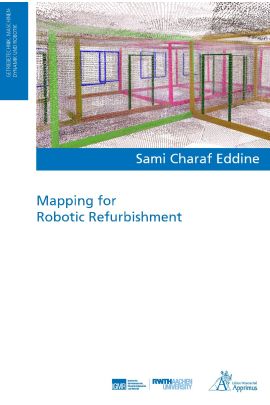Mapping is essential for robotic refurbishment. On the one hand, it is necessary for navigating the mobile robot. On the other hand, it provides semantic information required for the planning and fulfillment of the refurbishment tasks. Moreover, visibility conditions may deteriorate due to by-products from refurbishment, such as dust, and hence, conventional sensors, e.g. camera or laser, become prone to erroneous measurement data.
This thesis presents a novel mapping approach that enables robotic refurbishment in both, regular as well as low visibility conditions. It employs a combination of sensors, among which a radar sensor ensures perception in low-visibility environments. From a computational point of view, the mapping approach is split in three modules: map creation in regular visibility conditions, semantic map augmentation, and map creation in low visibility environments.
To create a 3D point cloud map of the environment a graph-based mapping approach is used. The edges and vertices of the graph are parametrized by dual quaternions, which allow to handle both, translation and rotation, jointly. Based on the concept of manifolds, the optimal configuration of the graph is computed and used to build the map of the environment. Subsequently, the created 3D point cloud map is semantically augmented by information required to plan and fulfill refurbishment tasks. To tell the robot on which surfaces to operate and how to move between the corresponding operating points, three types of information are inferred: Architectural information about processable areas (i.e. walls, floors, and ceilings), interior information about non-processable areas (i.e. traversable and avoidance objects), as well as topological information about rooms (i.e. subsets of connected walls). To account for declining visibility, a radar-based 2D grid mapping approach is presented. Here, a framework widely used for lidar-based perception is adapted and modified with regards to radar-based sensing.
Experimental validation demonstrates that the presented mapping approach is able to model refurbishment sites as required for operating a mobile robotic system in this field of application. The obtained maps provide a lightweight visualization of all inferred semantic information and enable both, the navigation of the mobile unit as well as the planning and fulfillment of refurbishment tasks.
| Autor | Charaf Eddine, Sami |
|---|---|
| Gewicht | 0.242 kg |
| Erscheinungsdatum | 04.06.2021 |
Eigene Bewertung schreiben
Getriebetechnik, Maschinendynamik und Robotik
Mapping for Robotic Refurbishment
ISBN: 978-3-86359-975-1
Lieferzeit: 2-3 Tage
39,00 €
inkl. 7% MwSt.
Kurzbeschreibung
This work presents a novel mapping approach to enable robotic refurbishment in both, regular as well as low visibility conditions. The computation is split in three modules: map creation in regular visibility conditions, semantic map augmentation, and map creation in low visibility environments. The obtained maps provide a lightweight visualization of all inferred semantic information and enable the navigation of the mobile unit as well as the planning and fulfillment of refurbishment tasks.
Auf Lager

